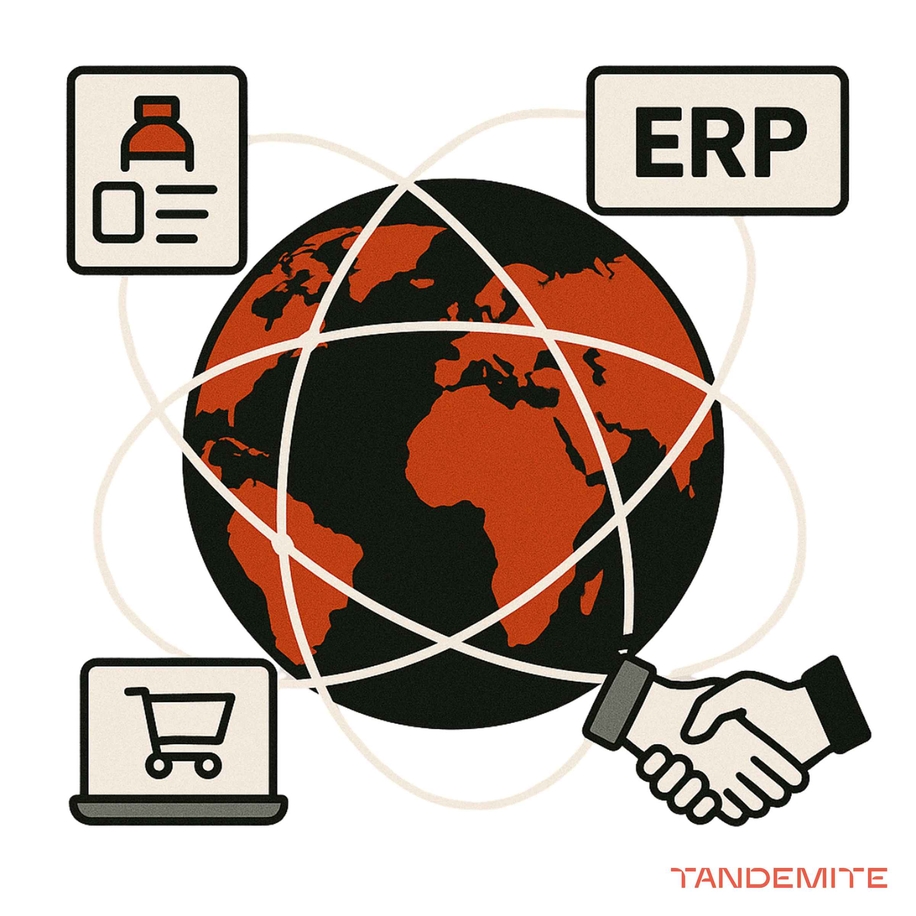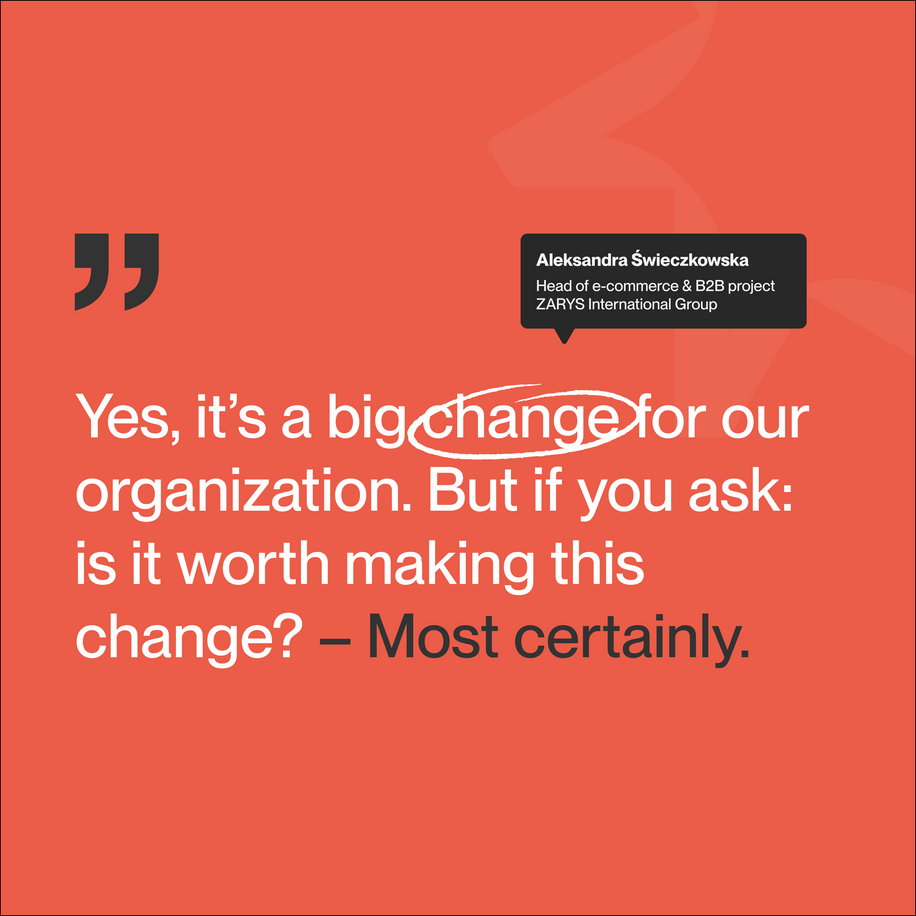Why ZARYS adopted PIM: One central product database – and countless issues prevented

Products are the lifeblood of any company. Yet when product information is hidden in countless files, buried in email threads, or remembered only by certain employees, efficiency drops and errors multiply.
ZARYS International Group – a Polish manufacturer of disposable medical equipment and healthcare solutions, steadily building its global presence through European branches and exports to many parts of the world – found itself at a crossroads. At the same time, the company was implementing SAP and developing its B2B platform. The business required a centralized environment where products could be fully defined and developed before reaching ERP systems and sales channels. That hub became the PIM system, delivered with the expertise of Tandemite.
„Data flowed loosely across the organization, residing in individual knowledge and on different computers. Without consolidating it into one complete framework, we were unable to achieve a true 360° product overview.” — Aleksandra Świeczkowska, Head of e-commerce & B2B project, ZARYS International Group
In this article, we examine the factors behind choosing PIM, the implementation process, and the lessons gained from that experience.
Challenge: Rapid growth, ERP change, and the start of e-commerce
„We discovered the need for a PIM once our processes were already mapped and we had chosen SAP as our ERP system. That’s when we thought it would make sense to tidy up our product data as well and implement a PIM system connected to SAP. Suddenly, there were many projects on the table, and coordinating them all became a huge task. The challenge was enormous.” — Adam Dziadkiewicz, Head of IT, ZARYS International Group
Three factors triggered change at ZARYS International Group:
- The introduction of a new ERP system (SAP) and the need to ensure proper integration.
- An expanded product range of 10,000 items, with the decision not to store “soft” product information in the ERP environment.
- The launch of additional sales channels (B2B platform on Shopware) and expansion into international markets.

This was a key turning point: bigger operations, new systems, and the beginning of e-commerce. Without cleaning and structuring product data, every new project would have brought higher costs and slower delivery.
Why Tandemite?
„Posing the right questions to our specialists, and then converting their feedback into a logically ordered software structure that also formed a consistent whole, was a highly important responsibility.” — Aleksandra Świeczkowska, Head of e-commerce & B2B project, ZARYS International Group
ZARYS needed a strategic partner who would:
a) leverage the knowledge of ZARYS’ product experts effectively,
b) create a data model that accurately supports the organization’s operational realities,
c) oversee the entire project lifecycle with a proactive approach to problem-solving, avoiding the transfer of responsibility.

How we approached the project:
- A full audit of the existing state and the preparation of a target model (“as-is” → “to-be”)
The project, initially undertaken by ZARYS International Group with another vendor, required our intervention midway. This takeover was completed without disrupting other major business priorities (SAP, B2B). Entering mid-execution, we prioritized knowledge transfer, structured analysis, and inventory of all existing components, refining the backlog and processes, and developing a complete map of integrations and interdependencies.
- Data model and editorial processes
When dealing with a portfolio of 10,000 SKUs, the first priority is to establish a clear, precise, and unified data model. Failing to do so means the current disorder will simply be reproduced in the new environment, one-to-one. The visible result might be a sleek, modern interface, but beneath it would remain duplicated records, conflicting attributes, and inconsistent units of measurement.
ZARYS products are defined not only by their names and descriptions but also by an extensive set of informational layers that shape the PIM model and workflow. We provided support in creating a standardized attribute catalog, a relational map (e.g., product–variant–set–accessory), and detailed dictionaries specifying the name, definition, type, mandatory status, and data owner. We also structured supported languages, measurement units, and variability rules, and set up quality standards, including validation processes and completeness requirements for each channel and language.
Our approach involved defining a product lifecycle framework (e.g., Draft → Review → Legal → Ready for Sale → Published) and setting specific mandatory elements for every stage, ensuring no gaps in information and eliminating disorder at the source.
„Our enduring goal is to enhance business processes and to improve the efficiency of the users who work within these systems. If we do not achieve this effectively, the likely outcome is that teams will fall back on Excel, as the process could prove inconvenient or insufficiently planned. This underscores the need to place strong emphasis on the strategic and consulting layer, ensuring the processes are optimised to the highest standard.” — Maciej Pałubicki, CEO, Tandemite
- Scrum in everyday work
When Scrum is part of daily operations, projects are delivered in short, focused iterations, with frequent demonstrations and decisions taken in a business-oriented setting. This approach discards the “waterfall” model and avoids long gaps before results emerge. The notion of a project revealing its impact only after nine months was never on the agenda.
- Integration with SAP ERP
Following the launch of PIM, an integration with the ERP system was implemented within one month. The data flow follows the PIM → ERP path for products eligible for sale.
We strategically divided the data scope between the two platforms and developed detailed conditions defining when and how data is exchanged:
The journey of a product in PIM starts with creating a draft, which holds the structural information about its family, variants, and EAN. This draft is then expanded with additional attributes such as written descriptions, technical specifications, images, documents, and translations into various languages.
Following this, the product enters the quality and compliance stage, which involves validating the data, checking for completeness, and obtaining the required approvals. Once a product receives the “Ready for Sale” status, it meets the data standards of the targeted sales channel.
When sent to SAP, it is further enriched with commercial details like pricing and stock information. The final publication to the B2B sales platform merges the “soft” content from Pimcore PIM with the “hard” operational data from SAP ERP.
The integration prevents PIM software from sending incomplete products to ERP, while ERP is restricted from providing price or stock details for blocked products.
- Transparent, maintainable solutions instead of over-engineering
We deliberately avoided introducing excessive complexity during the initial build. Instead of implementing heavy design patterns from day one, we created a simple, well-structured data model and an MVP of the most important functionalities. This ensured both easier maintenance and smoother feature expansion.
The MVP enabled us to launch key features quickly, and after validating the core foundations, we gradually added new capabilities (e.g., B2B, automation workflows).
We have implemented a workflow for the editorial team, supported by validation rules and a carefully selected list of core (yet critical) fields, to prevent the submission of content lacking essential data (it could cover aspects such as a minimum 2000 px image, a bilingual (ENG/PL) description up to 500 characters, key product parameters, and required PDF files).
Most important decisions and lessons learned from the project
1) Creating one source of truth as a real organizational shift
Installing a PIM system is only one part of the change. ZARYS formed a Data Management team specifically tasked with ensuring the quality and distribution of product information. Responsibility is clearly assigned to individuals – not distributed vaguely among many.
Key lesson: Avoid launching PIM without clear data ownership. Define the responsible roles, governance policies, and operational routines from the very beginning.
2) MVP over full-scale rollout
„PIM and B2B implementation is about acting within months, not stretching it over years. Releasing a foundational version quickly and refining it iteratively is the way to go.” — Maciej Pałubicki, CEO, Tandemite
Key lesson: Prioritize the most crucial datasets and core operations at the start, then scale up progressively through short, manageable sprints. Don’t import everything at once – plan multiple phases with 5–10% of the data per stage, adjusting mappings iteratively. This strategy helps deliver early wins and enables safer, more accurate final rule deployment across the entire product range.
3) Close integration of PIM, ERP, and e-commerce systems
At ZARYS, PIM solution provides product card content – photos, EAN numbers, descriptions, conversion units – while SAP updates prices and stock levels for B2B users logged in to the platform.
Key lesson: Plan the full lifecycle of your products before integrating systems. Include stages like creation, internal approval, and publishing to end platforms. Always factor in potential compliance or legal blocks.
Make sure to define the boundaries of PIM and ERP roles to avoid overlapping data and inconsistencies.
4) Shifting from a vendor-based approach to a collaborative partnership
„We appreciate partners who don’t dictate a single ‘correct’ method, product, or viewpoint. Each organization operates differently. Flexibility, listening, and understanding are essential to us – and in this cooperation, we found them all. This adaptability and alignment brought true added value.” — Adam Dziadkiewicz, Head of IT, ZARYS International Group
Key lesson: A PIM implementation is most effective when founded on collaboration between partners with defined roles and mutual objectives (in the ZARYS International Group project, Hostersi handled the infrastructure, and Tandemite developed the application).
Technology partners must provide critical analysis and dependable support, not merely follow instructions. Transparent, ongoing communication (particularly in difficult phases) is critical to delivering long-term value.
After implementing PIM, ZARYS experienced major improvements
✅ Consistent product information: A single, reliable source containing all product details, with smooth data exchange between departments and integrated systems.
✅ Strict quality standards: Enforced mandatory data fields, version control, structured workflows, and linked materials – from marketing brochures to technical manuals and images.
✅ Faster product launches: Product development can take place within PIM without halting ERP operations.
✅ Scalability and market readiness: Ability to manage multilingual content, various price lists, and contracts without retyping information; ready for B2B growth and international expansion.
✅ Improved partner cooperation in Poland and internationally.

Read more about how PIM and a modern B2B platform transformed ZARYS’s operations.
Common questions asked about PIM projects
Will PIM take the place of ERP?
No. The PIM system is intended for comprehensive management of product information. Data should be segregated by function:
- PIM (soft data): descriptive product content and contextual details for commerce and publishing purposes.
- ERP (hard data): transactional, regulatory, and operational control data.
What are the main risks?
Common risk factors include having a vague or inconsistent data model, not assigning clear responsibility for specific data sets, delivering every feature at once instead of taking an MVP-first approach, and failing to correctly estimate the effort required for migrating data to the PIM solution. Choosing the right partner helps to reduce these risks through proven methods and an agile sprint framework.
How to prepare within the company?
- Appoint a PIM Product Owner along with data owners from marketing and product departments.
- Write down the critical attributes – marking what is mandatory and outlining requirements for each channel and language.
- Prepare a detailed map of all systems and data sources used.
- Establish governance principles – determine who assigns product identifiers, who authorizes publications, and what criteria define acceptable quality.
Is PIM only useful in the e-commerce sector?
No. PIM systems support any business that manages a large number of SKUs, operates across multiple sales channels, and sells in various markets.
Does setting up PIM take a long time?
No. The basic version can be implemented in a few months. We use an MVP + iteration process, which lets us test ideas quickly with actual data and minimizes the chances of overengineering the solution.
If our project has started but is not unfolding according to plan, what can be done?
The Tandemite team brings proven expertise in taking over ongoing digital projects. Our process involves auditing the current model, optimizing the backlog, piloting a migration, and redefining the scope, with the MVP as the main focus.

The decision by ZARYS International Group to invest in a PIM tool stemmed from a clear objective: to transition from the disarray of multiple spreadsheets to one authoritative product repository. The journey covered more than technology – although Pimcore CE and SAP integrations played a key role – it was also about process: starting with workshops and building a data model, moving through iterative implementation, and supporting the organization through change.
Select a partner who listens carefully before implementing solutions. We welcome you to schedule a consultation.






